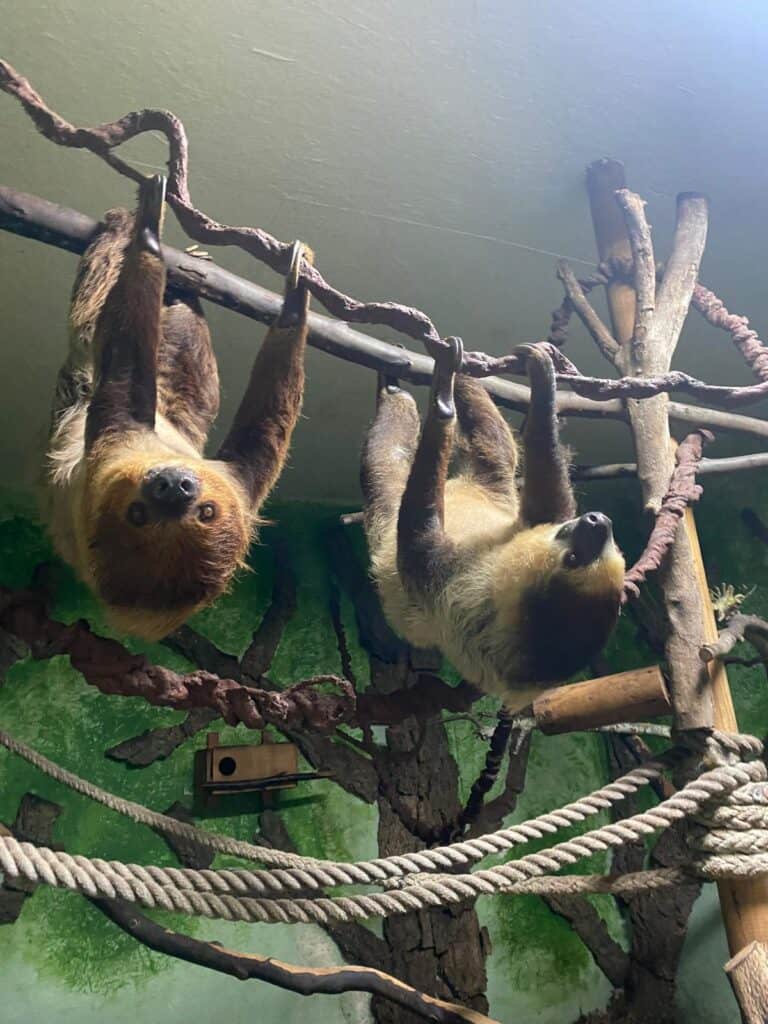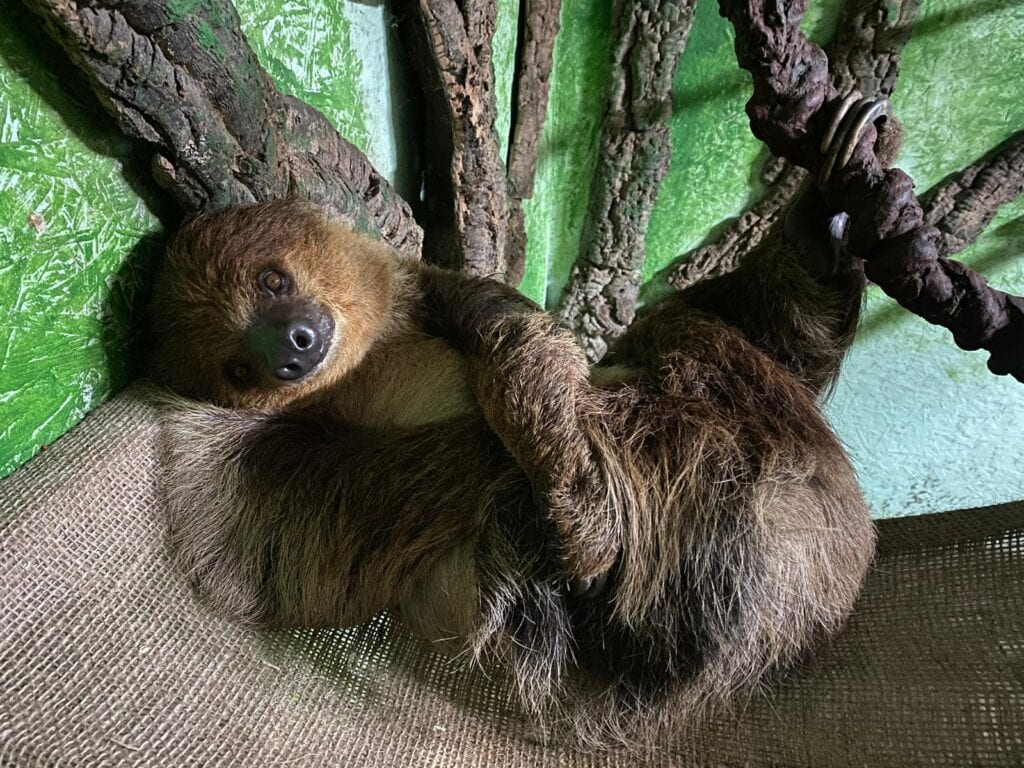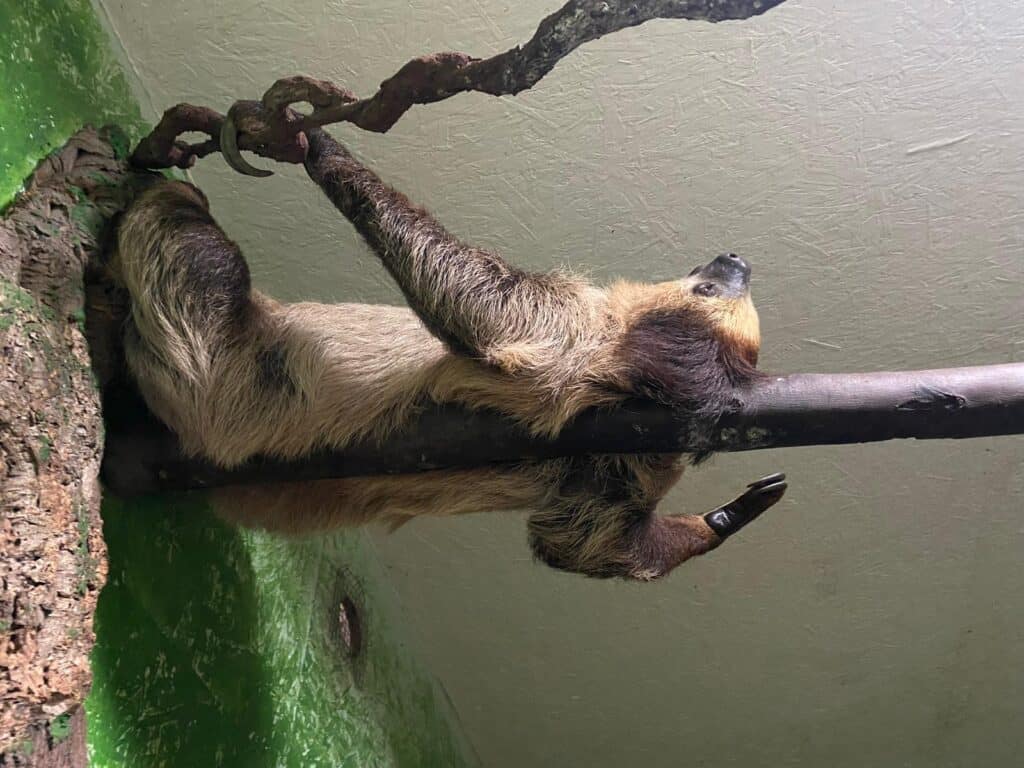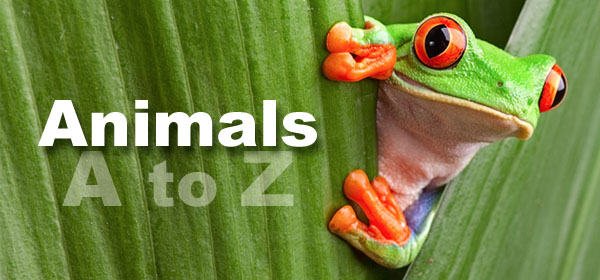Next Monday marks International Sloth Day, so this week my blog will be telling you all the weird and wonderful facts about our Linnaeus’ two-toed sloths, we have two sloths (located upstairs in the chimpanzee habitat); Sid is our male and Noco is our female.

There are 7 species of sloth- which are split into two families, three-toed and two-toed.
Three-toed Sloth
- Brown-throated sloth (Bradypus variegatus)
- Maned sloth (Bradypus torquatus)
- Pale-throated sloth (Bradypus tridactylus)
- Pygmy three-toed sloth (Bradypus pygmaeus): A critically endangered species.
- Southern maned sloth (Bradypus crinitus)
Two-toed Sloth
- Hoffmann’s two-toed sloth (Choloepus hoffmanni)
- Linnaeus’ two-toed sloth (Choloepus didactylus)
Interestingly, all sloths have 3 toes on their hind legs and it is only the forelimbs that have the different amount of toes.

Slow and Steady
Sloths have a reputation for being lazy—and to be fair, they do spend 15 to 20 hours a day sleeping! But this slow lifestyle is actually a brilliant survival strategy.
By moving slowly and staying high in the trees, they avoid predators like jaguars, ocelots and harpy eagles. Their slow metabolism also helps them conserve energy in environments where food isn’t always abundant. It takes a sloth 30 days to digest one leaf so they have the slowest digestion of any mammal.
Because of their slow digestion, sloths only poop about once a week—which is great news for us keepers!
But here’s where it gets a little weirder: instead of doing their business from the safety of the trees, sloths climb all the way down to the forest floor to poop. This behaviour is dangerous and energy-consuming, and scientists still aren’t entirely sure why they do it.
There are a few theories though:
- Moth Hotels
Sloths have a unique symbiotic relationship with sloth moths that live in their fur. When sloths descend to the forest floor, the moths lay their eggs in the faeces. The larvae then grow, and new adult moths return to live in the sloth’s fur. - Territory or Mating Signals
Some scientists believe defecating at the base of a tree may be a way for sloths to mark their territory or signal their reproductive status to other sloths. - Fertilising Their Favourite Trees
Another theory suggests that sloths may defecate at the base of their preferred feeding trees, acting as natural fertilisers to help those trees grow stronger.
Whatever the reason, it’s one of the biggest mysteries in sloth behaviour. Also a sloth can lose up to a third of its body weight in one toilet trip.

You may also not know that sloths are actually really good swimmers and can swim about 3 times faster than they can move on land! Swimming helps them to conserve energy as their natural buoyancy makes it easy for them to navigate in the water.
Noco, our female sloth, is just over 4½ years old—which means she’s already reached sexual maturity, as most two-toed sloths do around 3 years old.
Sloth reproduction is a slow and steady process, just like everything else in their lives. Their gestation lasts for around 6 months where they will typically give birth to a single baby, twins are extremely rare. They baby will stay with its mother for around 1-1.5 years, clinging to her belly and learning how to navigate the treetops. After that the young sloth will set off to live a solitary life, as sloths are generally loners by nature. Sloths only come together to breed and they don’t form family groups like some other mammals.

Interestingly, when a female sloth is in estrus (her monthly reproductive cycle), she becomes noticeably more active and vocal, calling out to attract a mate. It’s one of the few times you’ll hear sloths making any noise at all!
Two-toed females do not show any visible signs of pregnancy, so without an ultrasound, it’s nearly impossible to tell when a female is expecting. Luckily though we have our resident vet, Georgia on hand so we have been able to start ultrasound training Noco, which has been very exciting. We also weigh our sloths every other week so we can keep an eye on her weight also.
If you would like to come and meet our lovely lady we offer an amazing sloth experience: CLICK HERE
By Jess B, Deputy Head of Primates


